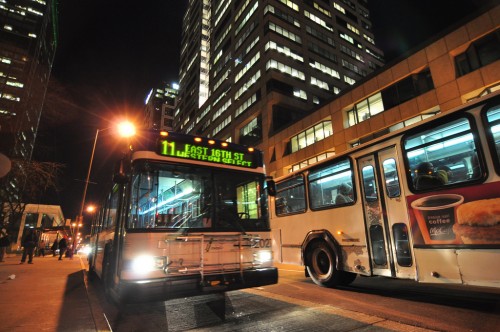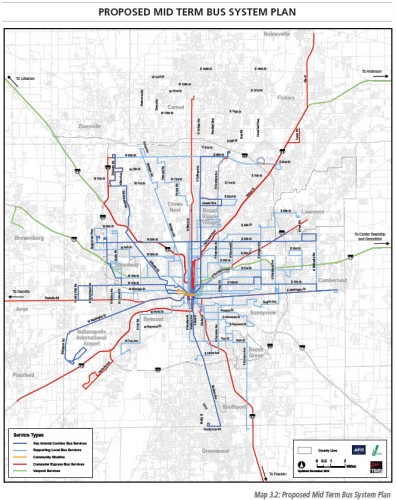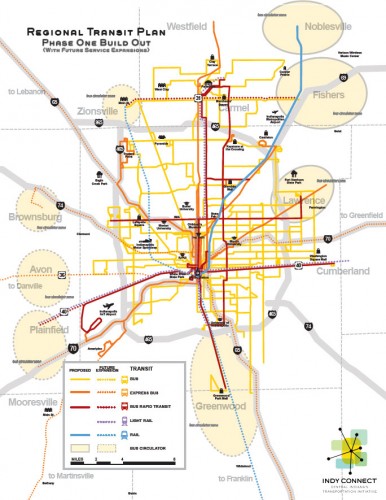A great bus plan was released to the citizens of Indianapolis on December 13th 2011. This plan proposes double the service over existing IndyGo bus service, identifies rapid transit corridors in the form of BRT (Bus Rapid Transit) and also spells out a future for a dependable bus service for the city of Indianapolis as well as Carmel.

However, if you were only a casual Indianapolis area resident, you may not know this. Since the release of the final Transit Task Force plan on the 13th, the local media has spent the better part of their share reporting on the NE Corridor commuter rail line; a service that would operate between Noblesville on the far NE side and Union Station in downtown Indy. Regular readers are more than familiar with the terms. However, selling a regional transit plan that is largely a bus plan to the public has become a tough debate. Media outlet have highlighted the narrow focus of rail service and associated affected citizens. A few conservative state lawmakers have put out press releases stating that their constituents shouldn’t have to pay for an unproven system that some would not use. Clouded in the rhetoric are the benefits of what is over-arching, a FANTASTIC bus plan.
Existing bus services would be upgraded to reasonable service headways. Additional local routes would be added. BRT corridors would see peak service headways in the 7.5 minute range. Along most routes, one wouldn’t have to pick up a schedule and watch the clock to plan on the next bus. Existing users of the system are familiar with this reality and the proposed changes would create a tremendous amount of value in time savings alone for riders. Choice riders would have many more reasons to leave the car at home and hop on a bus to work instead.

Kevin explored the IndyGo Comprehensive Operational Analysis a while back with a focus on the short term bus plan. For those of you willing to brave the many pages of transit planning, a recognizable trend might emerge. The Indyconnect Bus Plan is very similar to the “Mid-Term” COA plan. There are some obvious differences of course. The new Marion/Hamilton Regional focus of the latest Indyconnect plan have trumped what the COA aimed to advise. However, a look at headway changes on all routes gives us an idea of what to expect. Current routes with 1 hour midday overheads would be reduced to 30 minutes. Key arterial service, where the bulk of existing boardings occur, would see a drastic reduction in overheads; many would be 10-15 minutes through the day. Additionally, the BRT routes that have been proposed would create an environment where there could conceivably be a bus no more than 5 minutes away whether its BRT or arterial service.
As far as BRT goes, design of such a route is still in question. Will Indy have dedicated lanes for buses like Cleveland? How far apart and where will stations be located? Some specifics we already know. The BRT routes will be “limited stop” service meaning, there would be real stations with digital readouts overhead giving accurate arrival times of the next bus. The buses would not stop between stations at sign posts like existing service does. This rapid service coupled with limited stops near employment and activity centers could provide, for those who live near these stations, a reliable means of quickly getting around the region without using a car. Living and doing business in Indy without a car, could become a reality with this bus system. Indeed, the fact that transit planners have identified these rapid transit corridors is an indictment of existing ridership trends on existing service.

We have debated the merits of the NE Corridor quite often here so it’s not worth spending more lip service arguing over whether or not it should be first, or built at all. That is not what this story is about. In closing, debating the merits of the proposed system based upon a single rail route to the NE suburbs misses the bigger picture of what is a great bus plan. In the coming months, detractors should focus on what the plan does for the region as a whole versus what it doesn’t do. Remember, we all pay taxes to build roads we don’t use and that it serves a much larger transportation network that benefits everyone, even non-users.
Great Post! The bus service is really the back bone to any good system. Even in cities with great rail service, you still can’t cover a majority of the area. Bus service allows so many conenctions and reaches a much larger percentage of the population. I find it difficult to believe that pushing better bus service would be tough politically. So many of the negative comments about the rail have cited improving bus service as a greater need. I think more people identify with the bus and see it as a necessity, not a luxury.
In a city where even seeing a bus is a gift, what a luxury it would end up being if we could rely on that system to get us where we need to go when we need to go.
A bus commute to Lafayette Square via Kessler Blvd. Need I say more, ethnic food lovers?
I’m surprised you didn’t already start your own commuter service to there…….
Why not just hop on the 38 bus down 13 blocks? I’m at 44th and Meridian and take this bus for a lot of those restaurants too.
Not very practical from my house. Could take a bike to the bus stop at 38th and Meridian, I suppose.
Thanks for the update. I saw the bit of an article on the plan in the Star, but couldn’t quite make out precisely what was involved. I’m afraid that I’m still not clear on what Bus Rapid Transit would really entail here as there are differing definitions apparently. Is there to be a dedicated lane just for buses? How else does it eliminate the time problem of stop and go traffic, construction, etc.?
One thing that I’ve not seen mentioned too frequently is, frankly, the aesthetics/comfort level of bus stations vs. train stations. Train stations tend to have a sense of permanence that lends itself to a more secure “feeling.” As one who occasionally takes the 18 from/to Downtown and Meridian-Kessler because I think I should, I find myself (a middle-aged guy) sometimes a bit overwhelmed by the fistfights, angry words, and loud music at some of the Downtown bus stops. I know nothing about stops in other parts of town, other than the quiet ones in Meridian-Kessler. I actually walk four blocks away from the nearest stop to another that is quieter and less threatening. It seems to me that ANY attempt to get car-centered people to try out a New! Improved! Bus System! will need to address this head-on. Someone in authority should be present at most stops, even if they are part of some sort of voluntary organization.
I agree. The downtown loop stops can be quite uncomfortable if the crowd gets loud and or unruly. Transit police need to be added into the equation just like in the bigger cities with regular patrols at the stops. New riders wont accept the way it is now.
Transit police? Probably not. Telling the existing IMCPD to keep a closer eye on things-probably. I remember when a builder put some upmarket townhouses near downtown and the Red Cross. I wondered about theft and a local policeman said they were instructed that NOTHING could be stolen during construction and the police were ordered to 24/7 watch – without fail. Crime really fell while construction was underway. There is ALWAYS a priority when resources are limited – and they always are.
Curt,
Really good of you to bring this to everyone’s attention. I had no idea about this at all. I would like to see light rail around Indianapolis as much as anyone though let’s strengthen what is already in place and make IndyGo as efficient and effective as possible.
Matt